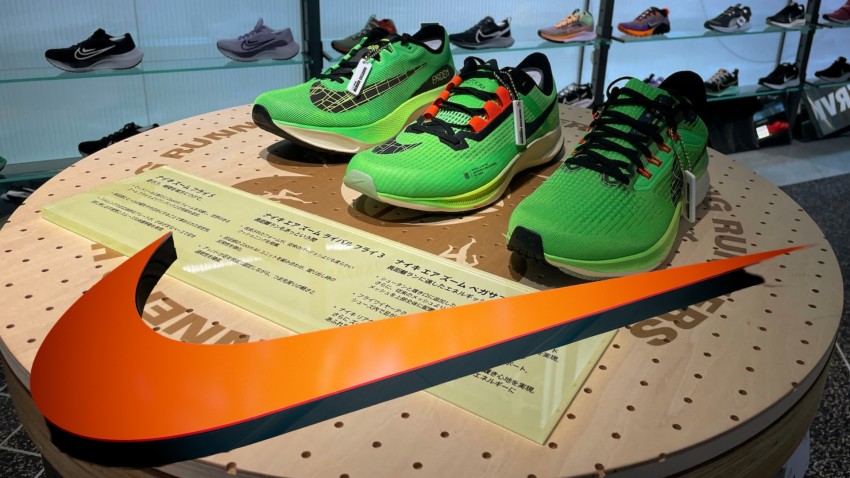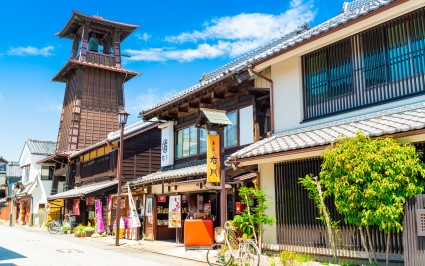On Nov. 22, 1962, Phil Knight, 24, sat on a plane bound for Tokyo. Instead of learning Japanese, Knight had spent the last 10 weeks with a friend in Hawaii, selling encyclopedias door to door, surfing and frequenting dive bars. He’d had better luck selling securities so, after earning a few commissions, he decided to leave his now-in-love friend behind and see about this “crazy” business idea he had involving running shoes.
As Knight rode in a taxi toward a “dingy hostel” in Tokyo, he saw that, even 17 years later, the city was still recovering from the bombings during the war.
“Vast sections of the city were total liquid black,” Knight recalled in his memoir, Shoe Dog. “For long, solemn stretches the cabdriver and I said nothing. There was nothing to say.”
Knight may not have been fluent in Japanese, but he admired Zen philosophy, and during his first few days, he took in temples, shrines and gardens, “trying to soak it all in.” He juxtaposed his harmonic pursuit of peace with a trip to the Tokyo Stock Exchange, where businessmen sat in various states of chaos, “waving their arms, pulling their hair, [and] screaming.”
Thankfully for Knight, his father, a newspaper editor in Oregon, had a few friends working at the United Press International (UPI). It was to these men that he “mentioned my Crazy Idea.” Simply put, Knight hoped to bring Japanese shoes into the Western marketplace, similar — he thought — to how high-quality Japanese cameras had gradually overwhelmed German cameras in the U.S. market.
The men were not impressed. Still, they did give him a useful tip, pointing him in the direction of the Importer, a monthly magazine. The expats there were a more captive audience than the UPI journalists. They still weren’t sure about Knight’s idea, but they did get out of him the brand of Japanese shoe he wanted to import — Onitsuka Tiger, located in Kobe and more familiarly known now as Asics.
Before making an appointment with the company and traveling by train to Kobe, the Importer staff had some sage advice when negotiating with Japanese businessmen: “It’s a culture of indirection,” they told him. “No one ever says, straight out, no. But they don’t say yes, either…don’t be cocky. You might leave a man’s office thinking you’ve blown it, when in fact he’s ready to do a deal.”
Negotiating with Onitsuka

“Mr. Knight — what company are you with?”
It was a simple question, but the young distance runner and Stanford business school graduate had not prepared for the simple. He’d only been stewing about the complicated sell of convincing the four Onitsuka executives at the table that there was a market for their shoe in the United States. So, dipping quickly into his childhood memories, he remembered the kind of ribbon he’d won after winning a race. Yes, go with that.
“Gentlemen,” Knight said to the executives. “I represent Blue Ribbon Sports of Portland, Oregon.”
Knight had made up the name of his one-man business on the spot.
Still, he marched on through his selling points. Knight himself was a runner, his personal best being a 4:13 mile, and he believed the right pair of shoes mattered. More importantly, Knight understood the American shoe market at the time. Adidas and Puma, German shoes, made up most of the sales in the U.S., but “If Onitsuka can penetrate the market,” Knight told them, “if Onitsuka can get its Tigers into American stores, and price them to undercut Adidas…it could be a hugely profitable venture.”
“How can I leave my mark on the world…unless I get out there first and see it? Before running a big race, you always want to walk the track.” —Phil Knight
Knight had already developed the numbers for his “crazy idea” in a research paper he completed at Stanford, and he’d endured a sardine-packed seven-hour train ride from Tokyo to Kobe, running lines in his head while smooshed against strangers. After he’d delivered all his talking points, there was a “prickling silence.” Moments later, Knight recalls, “they were all speaking over one another in loud, excited voices. Not to me, but to each other.”
And that was it. No closure. No, “we’ll let you know.” To Knight’s memory: “they all stood and left.”
If Knight had understood Japanese, he’d have been spared the suspense. Minutes after leaving, they came back with shoe samples, and executive Ken Miyazaki, who later left the company, reassured Knight: “We’ve been thinking [a] long time about [the] American market.”
Two hours later, Miyazaki and Knight came to an agreement. Knight would represent Onitsuka Tiger shoes in the U.S. Knight immediately contacted his father and told him to send Onitsuka a $50 money order so that a shipment of shoes would be sent to his family’s home in Portland, Oregon.
Four months later, Knight, after an incredible world tour where he visited over a dozen cities and stood at the Acropolis in Greece, was back home in Portland. The shoes arrived soon after.
The beginning of Nike
In Shoe Dog, Knight, via his ghostwriter, the impeccably readable J.R. Moehringer, describes the trials and tribulations that followed, whether selling Tigers at track meets out of the back of his car up and down the West Coast, securing loans for ever-increasing shoe orders, battling a shadowy competitor nicknamed “The Marlboro Man,” (wrestler Bill Farrell) to even outrightly lying to Onitsuka about having a storefront presence on the East Coast (he quickly opened one right after… it was the sixties, remember, and Knight had the indefatigable Jeff Johnson as an employee), Knight grew Blue Ribbon into a stable force.
But it took years for Knight (along with former coach and co-founder Bill Bowerman) to officially launch Nike, a word that is not mentioned in a company context until page 183, when Johnson “dreamed” it into existence.
Still, through his yearslong partnership with Onitsuka, Knight built the infrastructure needed to transition to his own brand. The breakup was painful, but necessary, with Knight pivoting to Nissho. It wasn’t until the 1972 Olympic trials, in Eugene, Oregon, about 10 years after his fateful trip to Kobe, that the Nike shoe was publicly unveiled: its “Swoosh” created for $35 by Carolyn Davidson, a then-graphic design student at Portland State University.
It was Knight’s genuine love of running and belief that shoes could make a difference in performance that, along with a good deal of fortuitous timing, led to his success. Admittedly naïve at 24, Knight followed his passion to Japan and came away with a business partner that would steer him toward greater success.
Just before embarking on that momentous 1962 trip, Knight wondered: “How can I leave my mark on the world…unless I get out there first and see it? Before running a big race, you always want to walk the track.”
Starting in February 2023, Japan Today will be introducing a new bi-monthly series by Patrick Parr on how famous brands got started in Japan. First up, the ubiquitous Starbucks...
Patrick Parr’s second book, One Week in America: The 1968 Notre Dame Literary Festival and a Changing Nation, was released in March 2021 and is available through Amazon, Kinokuniya and Kobo. His previous book is The Seminarian: Martin Luther King Jr. Comes of Age, now available in paperback. He teaches at Lakeland University Japan’s campus in Ryogoku, Tokyo.
© Japan Today Take our user survey and make your voice heard.
Take our user survey and make your voice heard.















4 Comments
Login to comment
Spitfire
Great article.
Thanks for this.
JeffLee
Fascinating story. I first heard of Nike circa 1975, when a jock of a junior high-school classmate got a pair with the waffle soul, which he used for cross-country running. The rest of us were curious, but overwhelmingly, we coveted Adidas, with Puma a distant second. I don’t recall Tiger until a few years later and it seemed a lot more esoteric than the other brands.
Laguna
My first pair of running shoes, bought in 1978, was the Nike Waffle Trainer. That was really the only running shoe on the market at the time, the others being multi-purpose "sports" shoes. Running shoes have come a long way since then. I look forward to this series.